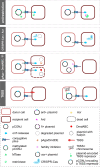The extended mobility of plasmids
- PMID: 40694848
- PMCID: PMC12282955
- DOI: 10.1093/nar/gkaf652
The extended mobility of plasmids
Abstract
Plasmids play key roles in the spreading of many traits, ranging from antibiotic resistance to varied secondary metabolism, from virulence to mutualistic interactions, and from defense to antidefense. Our understanding of plasmid mobility has progressed extensively in the last few decades. Conjugative plasmids are still often the textbook image of plasmids, yet they are now known to represent a minority. Many plasmids are mobilized by other mobile genetic elements, some are mobilized as phages, and others use atypical mechanisms of transfer. This review focuses on recent advances in our understanding of plasmid mobility, from the molecular mechanisms allowing transfer and evolutionary changes of plasmids to the ecological determinants of their spread. In this emerging, extended view of plasmid mobility, interactions between mobile genetic elements, whether involving exploitation, competition, or elimination, affect plasmid transfer and stability. Likewise, interactions between multiple cells and their plasmids shape the latter patterns of transfer through transfer-mediated bacterial predation, interference, or eavesdropping in cell communication, and by deploying defense and antidefense activity. All these processes are relevant for microbiome intervention strategies, from plasmid containment in clinical settings to harnessing plasmids in ecological or industrial interventions.
© The Author(s) 2025. Published by Oxford University Press on behalf of Nucleic Acids Research.
Conflict of interest statement
None declared.
Figures








Similar articles
-
Horizontal Gene Transfer Systems for Spread of Antibiotic Resistance in Gram-Negative Bacteria.Microbiol Immunol. 2025 Jul;69(7):367-376. doi: 10.1111/1348-0421.13222. Epub 2025 May 15. Microbiol Immunol. 2025. PMID: 40370256 Review.
-
Mechanistic divergence between SOS response activation and antibiotic-induced plasmid conjugation in Escherichia coli.Microbiol Spectr. 2025 Jul;13(7):e0009025. doi: 10.1128/spectrum.00090-25. Epub 2025 May 28. Microbiol Spectr. 2025. PMID: 40434128 Free PMC article.
-
Horizontal Gene Transfer and CRISPR Targeting Drive Phage-Bacterial Host Interactions and Coevolution in "Pink Berry" Marine Microbial Aggregates.Appl Environ Microbiol. 2023 Jul 26;89(7):e0017723. doi: 10.1128/aem.00177-23. Epub 2023 Jul 5. Appl Environ Microbiol. 2023. PMID: 37404190 Free PMC article.
-
Short-Term Memory Impairment.2024 Jun 8. In: StatPearls [Internet]. Treasure Island (FL): StatPearls Publishing; 2025 Jan–. 2024 Jun 8. In: StatPearls [Internet]. Treasure Island (FL): StatPearls Publishing; 2025 Jan–. PMID: 31424720 Free Books & Documents.
-
Factors that influence parents' and informal caregivers' views and practices regarding routine childhood vaccination: a qualitative evidence synthesis.Cochrane Database Syst Rev. 2021 Oct 27;10(10):CD013265. doi: 10.1002/14651858.CD013265.pub2. Cochrane Database Syst Rev. 2021. PMID: 34706066 Free PMC article.
References
-
- Arnold BJ, Huang I, Hanage WP Horizontal gene transfer and adaptive evolution in bacteria. Nat Rev Micro. 2021; 30:206–18. - PubMed
Publication types
MeSH terms
Grants and funding
LinkOut - more resources
Full Text Sources

